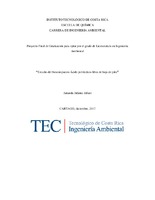Estudio del biocompuesto Ácido poliláctico-fibra de hoja de piña
Resumen
There is an important production of pineapple in Costa Rica, approximately 40 thousand hectares, which produce 70 tons of biomass after harvesting the fruit. One of the products that can be extracted from this waste is the pineapple leaf fiber (PALF). The use of natural fibers, such as PALF, is technically viable due to its continuous supply, easy and safe handling and biodegradable nature. With this fiber it is possible to produce PALF composites with a variety of applications, since the PALF can affect the mechanical, thermal and biological properties of the final products. In this study, PALF was used in the formulation of a composite based on polylactic acid (PLA). Four types of mixtures were produced with 2%, 6%, 11% and 22% (dry weight) fiber in a PLA matrix. The mixture of PLA and PALF was mixed by means of a Brabender mixer and then the material was milled, to then make the test tests by thermocompression. Physical, mechanical and thermal properties were evaluated for comparison with pure PLA. In addition, scanning electronic microscopy (SEM) analysis was performed to study the compatibility between the fibers and the PLA matrix. The results showed that mechanical and thermal properties improve with the addition of fiber, without a significant difference between fiber treatments, while the SEM micrographs show good fiber distribution. The PLA-PALF interaction was analyzed with DSC, showing good results. The PLA-PALF composite showed satisfactory properties to be tested as a biodegradable material.
Descripción
Proyecto de Graduación (Licenciatura en Ingeniería Ambiental) Instituto Tecnológico de Costa Rica, Escuela de Química, 2017.


